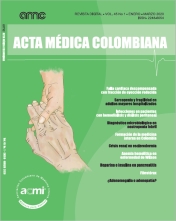Microbiological diagnosis in febrile neutropenia secondary to chemotherapy for hematologic malignancy
Cohort description
Abstract
Objective: to describe the demographic, clinical, therapeutic and microbiological characteristics of patients with hematological malignancies undergoing chemotherapy who develop febrile neutropenia during treatment, as well as the mortality at discharge.
Methods: a retrospective cohort study of patients with hematologic neoplasms who developed febrile neutropenia and were seen at the Hospital Universitario San Vicente Fundación in Medellín.
Results: records of 110 episodes of febrile neutropenia were obtained. The mean age was 45 years. In 55.4%, a microbiological diagnosis was obtained; bacteremia was documented in 83.8% of these. The most common microorganisms were K. pneumoniae (30%) and E. coli (18%). Antibiotic resistance due to ESBLs or carbapenemases in gram negative bacilli was 33%. Death occurred in 17% of patients. Acute lymphocytic leukemia (ALL) and acute myeloid leukemia (AML) were the most prevalent underlying diagnoses; the most prevalent clinical focus was bacteremia (24.5%).
Conclusion: in our case series, there are significant differences in the percentage of patients with bacteremia, as well as in global mortality, compared to the rest of the cohorts in the region.
A new research study needs to be carried out to clarify the source of these differences
Metrics
Acta Medica Colombiana uses the CC-BY 4.0 license. Authors retain all rights over their work.


